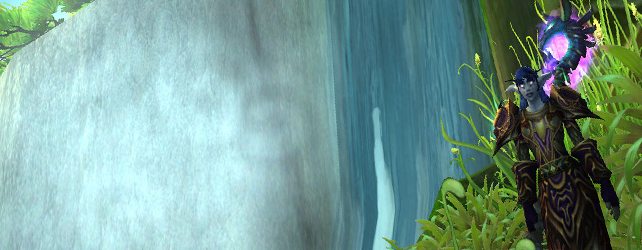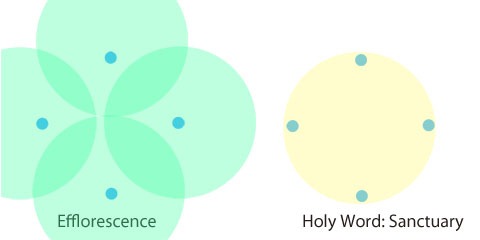This is a guest post by Arajal about a more in-depth look at Symbiosis.
The WoW blogosphere has been abuzz with talk about druids’ new spell, Symbiosis. Needless to say, it’s something that has many druids excited. I’m no exception to this; as both a resto druid and a healing coordinator, I’m especially interested in Symbiosis’ possibilities. I figured I’d throw up another guest post that looks at the practicality of each synergy a resto druid has available to them through this spell.
Note: We’re still in early beta, and these spells are more than likely to change. I’ll re-evaluate new combinations as they come up, but for the time being, this is what I have to work with.
Death Knights
Linking Symbiosis with our disease-wielding undead friends will yield Icebound Fortitude for a resto druid. This is a link I could see having strong benefits in both PvE and PvP, moreso for the latter.
In PvE, I wouldn’t be surprised to see bosses equipped with a random single-target or group stun ability, in which case using Icebound Fortitude would open a window for healing that otherwise wouldn’t exist. Plus, the 20% damage reduction is like a second Ironbark (albeit on a slightly longer cooldown and only self-cast like Barkskin).
In PvP, this link’s benefit shines far more brightly. Having a cooldown to make yourself immune to stuns and drop incoming damage by 20% would help immensely while being focused, something resto druids are likely to be the victims of. Even while not being focused, being immune to stuns during clutch healing situations can be the difference between a win and a loss.
As for what our death knight friends get out of the link, Wild Mushroom: Plague is a very nice ability for spreading diseases without expending runes, freeing them up for more DPS abilities. Looking over at Blood’s spell, they get a very nice health cooldown through Might of Ursoc that not only increases total health by 15% (similar to Vampiric Blood), but also brings their health up to 15% should they need it.
Hunter
Linking with a hunter gives a resto druid Deterrence. As far as I’m concerned, this is one of the better Symbiosis links if you’re concerned with both self-preservation and mobility. While it won’t clear any debuffs you have, it will prevent any incoming damage and suppress any damage you are taking by 30%, giving other healers some breathing room to help you out. Unfortunately, it currently does prevent you from casting any heals of your own, but being able to gain temporary immunity to damage while still retaining the ability to move is worth the trade off in my eyes.
Deterrence in PvP will definitely be a boon to any healing druid should they find themself there. Being able to “deter” (see what I did there?) any DPS trying to focus you down can have a huge impact on the tide of battle. Even if it’s only for a few seconds, it will still give you some breathing time to figure out your next move. Heck, you could just use it for a few seconds to keep the pressure off, then cancel the buff and go back to healing.
Hunters get Dash out of the deal, and while they already have spells like Disengage and Aspect of the Cheetah or Aspect of the Pack, it still gives them one more tool to get from point A to point B in critical situations. I know the hunter in my normal raid group would love a new way to get around the field quickly.
Mage
If total self-preservation is your cup of tea, link with a mage. A resto druid gets Ice Block from using Symbiosis on a mage, and aside from Divine Shield (which our fellow kitties get from linking with a paladin), Ice Block is the best way to survive in clutch situations. The number of times an Ice Block could have saved our raid or at least helped in wipe recovery are innumerable.
Much like Deterrence from hunters, Ice Block is a very useful spell to use when healing is at a premium in PvE or you’re getting focused in PvP. The benefit of taking Ice Block over Deterrence is the removal of all debuffs and total immunity to all harmful effects, but at the cost of mobility. While popping Ice Block in a circle of fire may save your life, not being able to move out of it while suppressing the damage may cause you some issues a few seconds later. That being said, being able to become completely immune to all incoming damage and effects for a few seconds is nothing to turn your nose up at.
As for the mage, Healing Touch is something they may or may not get any benefit out of. It all depends on if they decide to use it or not. In PvE, being able to heal and otherwise take some pressure off the healers is something both our raid leader and myself stress the DPS to consider. In PvP, casting Healing Touch is a very good way to keep afloat in chaotic free-for-alls or to eat a spell interrupt (since Healing Touch is the only nature school spell they’ll have, they’ll be free to cast other spells unhindered).
Monk
Unfortunately, linking with a monk yields nothing for the druid right now. It’ll be interesting to see what Blizzard decides to give us in future beta builds.
On the other side of the link, Monks get some fairly nice abilities from our arsenal. Brewmaster tanks enjoy Survival Instincts for a 25% reduction of incoming damage for a few seconds, adding to their already formidable array of mitigation and avoidance abilities. Windwalker Monks get to have fun with a mini-Evasion in the form of Savage Defense; something that will undoubtedly be more prevalent in PvP, but I could see PvE applications as well, mainly in the form of emergency off-tanking through Provoke and evasive spells. Our fellow healing monks gain Cyclone, perfect for CC emergencies in PvE or controlling opponents in PvP.
Paladin
The dispel-happy healer in me gets giddy over this one. Casting Symbiosis on a paladin gives a resto druid Cleanse, making our debuff-removal power absolute (I’m not counting bleeds as removable debuffs, since that power is limited to Monks at the moment). The ability to remove all debuffs of any type on a target is immensely useful in both PvE and PvP. While I haven’t yet had the chance to check whether or not Cleanse and Nature’s Cure share a cooldown, even having the ability to clear any debuff type on a whim is incredibly powerful. Just imagine using the combination of debuff-removal spells on a flag carrier in a battleground. That’d be a tide-changer without question.
Holy paladins get Rebirth through Symbiosis, a benefit that depends largely on your raid composition and size. That being said, having another battle rez at your raid’s disposal is never a bad thing. Protection paladins get another defensive cooldown in the form of Barkskin. 10% damage reduction on a one-minute wait time doesn’t sound all that bad.
Retribution paladins currently don’t get anything out of Symbiosis, but that’ll change in future builds.
Priest
It’s payback time indeed, Matt. Resto druids get Leap of Faith (a.k.a. Life Grip) through linking with a priest. All griefing and tomfoolery aside, Leap of Faith will be an incredible tool to add to a mobility-minded healing druid’s toolkit. Pulling a melee out of a nasty cleave or a ranged player away from a void zone are both very pertinent situations for Leap of Faith in PvE. In PvP, ripping your teammates out of harm’s way in arenas or yanking the flag carrier closer to your side of the field in CTF battlegrounds can make a very large impact on the battle at hand. Add the Wild Charge talent into the mix with Leap of Faith and you’ll have a lot of control over the flow of a battle.
While I can get behind shadow priests getting Tranquility, the spell the other two priest specs get is one that leaves me scratching my head a little. I can see a few merits to disc and holy priests being able to use Entangling Roots to stop melee attackers in their tracks, but in the fray of PvP, where damage is flying around and any CC that isn’t a stun or knockdown tends to break, I don’t see roots being used very much, and on the off chance they do get used, they won’t last very long. In PvE, I could see some use for the roots on large trash pulls with melee mobs, but that remains to be seen.
Rogue
Linking with a rogue gives us Evasion, something that I think will go hand-in-hand with our Heart of the Wild level 90 talent. Any healing druid in the “jack-of-all-trades” mindset that intends to be an off-tank for short periods of time will benefit greatly from linking with a rogue. Evasion for a resto druid is like a slightly better version of the Guardian-spec-only ability Savage Defense. This all goes without saying of the benefits in PvP, of course. Using Evasion against a group of melee players trying to focus you down gives you 15 seconds to breath a little and throw heals on yourself.
Similarly to what I mentioned for the Windwalker monk earlier, a rogue with Growl (their Symbiosis spell) can fill the clutch off-tank role through evasion skills, such as Evasion (duh) and Cloak of Shadows, if need be.
Shaman
A resto druid linked with a shaman gains Spiritwalker’s Grace. While it may seem counter-intuitive for a class that relies mainly on instant-cast heals, there are benefits to being able to cast on the move. Anyone who has grabbed feathers while healing during Alysrazor in Firelands will know what I’m talking about. Being able to cast Healing Touch, Regrowth, or even Nourish while on the move can be a deal-breaker in many a situation, be it PvE or PvP. Need to move alongside the tank while he kites the boss? No worries! Flag carrier needs healing heavy healing for all the DoTs stacked on them? Problem solved!
Enhancement and elemental spec shaman get Solar Beam from Symbiosis. Locking down a caster target underneath a Solar Beam can be incredibly useful, especially if they can’t move. Giving this spell to a class that already has a number of slowing and snaring tools at its disposal is icing on the cake as far as I’m concerned. Also, it gives these specs another interrupt spell as well, should a situation call for it. Flipping over to restoration shaman, Symbiosis gives them Prowl. I haven’t been able to find a shaman to test this with on the beta yet, but if it can be cast while in combat like Vanish, it’ll make a very nice wipe-prevention and/or focus-prevention ability.
Warlock
Linking with a warlock gives a resto druid the neat ability to remove all snares and teleport to their new warlock friend’s Demonic Circle. Of all the current Symbiosis spells healing druids get, this one is my favorite. The entire concept of the Demonic Circle for warlocks has always been appealing to me, and being able to finally play around with the mechanic makes me a very happy druid. In terms of practicality, it’s very similar to the Wild Charge talent while in humanoid form, but with a longer range and snare-breaking capability.
The usefulness of giving a warlock Rejuvenation is no different than the usefulness of giving a mage Healing Touch. Like I said earlier in this post, it all depends on whether your warlock chooses to use the spell or not.
Warrior
Casting Symbiosis on a warrior yields Intimidating Roar. In essence, this gives us a second, slightly different version of one of our level 75 talents, Disorienting Roar, with the disorient effect being replaced by a fear. If you’re a druid that didn’t take the Disorienting Roar talent, this gives you a tool you otherwise don’t have. If you did take Disorienting Roar, this gives you a second defensive AoE spell to play around with. Either way, the spell will be immensely useful in situations where many small adds are spawning faster than the tank can round them up. Resto druids, at least currently, tend to draw a lot of threat during healing-intensive situations where many adds are spawning in quick succession (I’m looking at you, Heroic Spine of Deathwing). Having Intimidating Roar in both PvE and PvP is a great way to keep attackers off for a few seconds while you heal yourself back into good health. Granted, if your attackers are immune to fear, you may run into some issues with this spell.
On the flip side of the link, warriors get some nice tools added to their kits. Arms and fury specs get Stampeding Roar, which is an amazing mobility spell for both themselves and others, no matter the situation. Protection warriors get Frenzied Regeneration, instantly convert the rage cost into health.
That wraps up my post. Thanks for reading!


